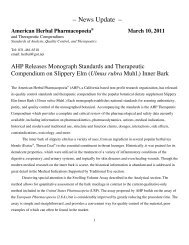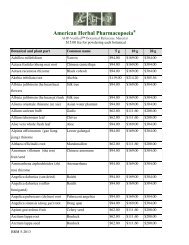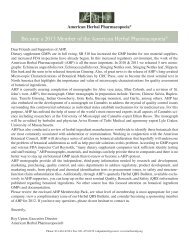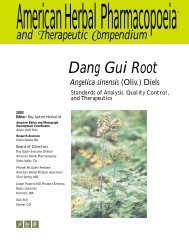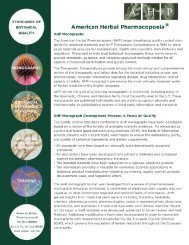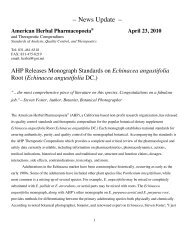alerian oot - American Herbal Pharmacopoeia
alerian oot - American Herbal Pharmacopoeia
alerian oot - American Herbal Pharmacopoeia
Create successful ePaper yourself
Turn your PDF publications into a flip-book with our unique Google optimized e-Paper software.
aspirin, lovastatin, ibuprofen, potassium, zinc, and vitamins. Additional interventions<br />
were applied in the course of the biopsy. The acute crisis occurred after administration<br />
of naloxone and subsequently stabilized over the course of 3 days. After being<br />
discharged the patient continued using v<strong>alerian</strong> and was stable at his 2-month and 5month<br />
assessments.<br />
Consumption of v<strong>alerian</strong> products have been implicated in at least five cases of<br />
liver toxicity (see Toxicology).<br />
Contraindications<br />
None cited in the literature (Blumenthal and others 1998; Bradley 1992).<br />
Interactions<br />
V<strong>alerian</strong> and some v<strong>alerian</strong> preparations have been shown to potentiate the effects of<br />
barbiturates (Bounthanh and others 1980; Hendriks and others 1985: Rosecrans and<br />
others 1961). At 2 mg/kg po an aqueous alkaline extract (5 to 6:1) increased thiopental-induced<br />
sleeping time in mice by a factor of 1.6 (P ≤ 0.01), and at 200 mg/kg po<br />
a 7.6-fold increase was observed. As a comparison, a 4.7-fold increase was observed<br />
with concomitant use of chlorpromazine (4.0 mg/kg po) (Leuschner and others<br />
1993). In older literature, it was reported that atropine decreases the hypotensive<br />
activity of v<strong>alerian</strong> by 50% (Rosecrans and others 1961). It has also been reported that<br />
v<strong>alerian</strong> has been used in conjunction with bromides and other sedatives. Specific<br />
data regarding the interaction are lacking (Evans 1989). Also reported in older literature<br />
is the ability of valepotriates (20 mg/kg iv) to reduce vasopressin and bariuminduced<br />
arrhythmia in rabbits (Petkov 1979).<br />
Pregnancy, Mutagenicity, and Reproductive Toxicity<br />
There is a significant amount of literature regarding the mutagenic potential of valepotriates.<br />
As previously stated, these compounds degrade rapidly and are typically not<br />
found in commercial preparations. These data are as follows.<br />
Valepotriates, such as valtrate and didrovaltrate, contain an epoxide group and<br />
thus possess alkylating properties. Part of the in vitro cytotoxicity of valepotriates may<br />
be due to their ability to interact with thiol-containing enzymes (Bos and others<br />
1998b). Two groups of valepotriates are distinguished: those of the diene type (valtrate,<br />
isovaltrate, and acevaltrate) and those of the monoene type (didrovaltrate and<br />
isovaleroxyhydroxydidrovaltrate). The cytotoxic potential of valerenic acid and its<br />
derivatives, as well as valepotriates and their derivatives, was investigated against a<br />
human small cell lung cancer cell line (GLC4) and a human colorectal cancer cell<br />
line (COLO 320) using the microculture tetrazolium (MTT) assay (Bos and others<br />
1998b). Those of the diene type displayed the highest cytotoxicity with IC50 values<br />
slightly higher than those of the cytotoxic agent cisplatin (GLC4: 1µM; COLO 320:<br />
3 µM) which was used as a comparison. Those of the monoene type were found to<br />
be 2- to 3-fold less toxic, and the decomposition products of valepotriates, baldrinal<br />
and homobaldrinal, were found to be 10- to 30-fold less toxic than their parent compounds<br />
(see Table 2).<br />
Valerenic acid and its derivatives (acetoxyvalerenic acid, hydroxyvalerenic acid,<br />
and methyl valerenate) displayed a low toxicity with IC50 values between 100 and 200<br />
µM. The cytotoxic potential of other compounds of the essential oil (valeranone,<br />
kessoglycl, monoacetate, kessoglycl diacetate, cryptofauronol, patchouli alcohol, and<br />
maaliol) were comparable to that of valerenic acid (see Table 1) (Bos and others<br />
1998b).<br />
<strong>American</strong> <strong>Herbal</strong> <strong>Pharmacopoeia</strong> • V<strong>alerian</strong> R<strong>oot</strong> • April 1999 Page 19



